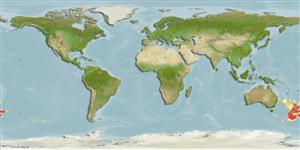Environment: milieu / climate zone / depth range / distribution range
Ecologia
marino demersale; distribuzione batimetrica 10 - 1500 m (Ref. 26346). Temperate
Southwest Pacific: endemic to New Zealand.
Length at first maturity / Size / Peso / Age
Maturity: Lm 59.0 range ? - ? cm
Max length : 118 cm TL maschio/sesso non determinato; (Ref. 26346); common length : 62.0 cm TL maschio/sesso non determinato; (Ref. 9258); Età massima riportata: 9 anni (Ref. 47618)
Short description
Chiavi di identificazione | Morfologia | Morfometria
Brown dorsally, mottled with white and black spots, and a large dark blotch on each wing; white ventrally (Ref. 26346).
Inhabit the continental shelf and upper slope (Ref. 26346); usually in coastal waters (Ref. 9258). Found partially buried in sand (Ref. 26346). Feed on fish, shellfish, crabs, and worms (Ref. 114953, 26346). Oviparous. Distinct pairing with embrace. Young may tend to follow large objects, such as their mother (Ref. 205). Eggs are oblong capsules with stiff pointed horns at the corners deposited in sandy or muddy flats (Ref. 205). Egg capsules are 10.2-12.7 cm long and 6.3-8.3 cm wide (Ref. 41249, 41308).
Life cycle and mating behavior
Maturità | Riproduzione | Deposizione | Uova | Fecundity | Larve
Oviparous, paired eggs are laid. Embryos feed solely on yolk (Ref. 50449). Young hatching at about 18-20 cm (Ref. 26346). Distinct pairing with embrace. Young may tend to follow large objects, such as their mother (Ref. 205).
McEachran, J.D. and K.A. Dunn, 1998. Phylogenetic analysis of skates, a morphologically conservative clade of elasmobranchs (Chondrichthyes: Rajidae). Copeia 1998(2):271-290. (Ref. 27314)
IUCN Red List Status (Ref. 130435: Version 2024-1)
Threat to humans
Harmless
Human uses
Pesca: commerciale
Strumenti
Special reports
Download XML
Fonti Internet
Estimates based on models
Preferred temperature (Ref.
123201): 7.4 - 12.6, mean 9.2 °C (based on 95 cells).
Phylogenetic diversity index (Ref.
82804): PD
50 = 0.6250 [Uniqueness, from 0.5 = low to 2.0 = high].
Bayesian length-weight: a=0.00302 (0.00141 - 0.00645), b=3.24 (3.07 - 3.41), in cm total length, based on LWR estimates for this (Sub)family-body shape (Ref.
93245).
Trophic level (Ref.
69278): 3.7 ±0.57 se; based on food items.
Generation time: 6.9 ( na - na) years. Estimated as median ln(3)/K based on 1
growth studies.
Resilienza (Ref.
120179): Basso, tempo minimo di raddoppiamento della popolazione 4.5 - 14 anni (Fec assumed to be <100).
Fishing Vulnerability (Ref.
59153): High vulnerability (59 of 100).
Climate Vulnerability (Ref.
125649): High to very high vulnerability (70 of 100).
Nutrients (Ref.
124155): Calcium = 4.7 [0.7, 81.8] mg/100g; Iron = 0.238 [0.022, 2.862] mg/100g; Protein = 14.8 [12.3, 17.9] %; Omega3 = 0.808 [0.354, 1.936] g/100g; Selenium = 20.5 [4.3, 103.7] μg/100g; VitaminA = 4.51 [0.33, 51.42] μg/100g; Zinc = 0.31 [0.02, 3.49] mg/100g (wet weight);
